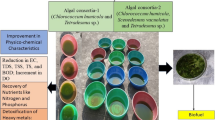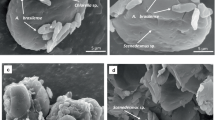Abstract
A set of experiments was conducted to provide significant insights of micro-algal consortia regarding chromium adsorption. Four monocultures; Scenedesmus dimorphus, Chlorella sp., Oscillatoria sp., and Lyngbya sp., and their synthetic consortia were evaluated initially for chromium bio-adsorption at four different regimes of hexavalent chromium i.e. 0.5, 1.0, 3.0 and 5.0 ppm. Based on findings, only 1.0 and 5.0 ppm were considered for future experiments. Consequently, three different types of monoculture and consortia cells namely; live cells, heat-killed cells, and pre-treated cells were prepared to enhance their adsorption potential. Maximal adsorption of 112% was obtained at the dose of 1.0 ppm with 0.1% SDS pre-treated consortia cells over live consortia cells. In support, atomic absorption spectroscopy, laser induced breakdown spectroscopy, pulse amplitude modulated chlorophyll fluorescence, and scanning electron microscopy were performed to assess the structural and functional changes within consortia and their utilization in mitigation of elevated chromium levels.






Similar content being viewed by others
References
Adinath RA, Singh SK, Dixit K, Sundaram S (2015) Chromium induced alterations in different individual microalga and their consortia. IJONS 6(32)
Ahuja P, Gupta R, Saxena RK (1999) Zn2+ biosorption by Oscillatoria anguistissima. Process Biochem 34:77–85
Behera S, Singh R, Arora R, Sharma NK, Shukla M, Kumar S (2015) Scope of algae as third generation biofuels. Front Bieng Biotechnol 2:1–13
Berg AK, Lyra C, Sivonen K, Paulin L, Suoimalainen S, Tuomi P, Rapala J (2009) High diversity cultivable heterotrophic bacteria in association with cyanobacterial water blooms. ISME J 3:314–325
Bharti N, Pandey SS, Barnawal D, Patel VK, Kalra A (2016) Plant growth promoting rhizobacteria Dietzia natronolimnaea modulates the expression of stress responsive genes providing protection of wheat from salinity stress. Sci Rep 6:34768
Bose SC, Suresh R, Ramakrishnan B, Megharaj M, Venkateshwarlu K, Naidu R (2011) Consortia of cyanobacteria/microalgae and bacteria: biotechnological potential. Biotechnol Adv 29(6):896–907
Brenner N, Joseph B, Jones M (2008) Theorizing sociospatial relations. Environ Plan D Soc Sp 26:389–401
Brun LA, Maillet J, Richarte J, Herrmann P, Remy JC (1998) Relationship between extractable copper, soil properties and copper uptake by wild plant in vineyard soils. Environ Pollut 102:151–161
Cardinale BJ (2011) Biodiversity improves water quality through niche partitioning. Nature 472:86–89
Cardinale BJ, Srivastava DS, Duffy JE, Wright PJ, Downing LA, Sankaran M, Jouseau C (2006) Effect of biodiversity on the functioning of trophic groups and ecosystems. Lett Nat 443(7114):989–992. doi:10.1038/nature05202
Cardinale BJ, Wright JP, Cadotte MW, Carroll IT, Hector A, Srivastava DS, Loreau M, Weis JJ (2007) Impacts of plant diversity on biomass production increase through time because of species complementarity. PNAS 104(46):18123–18128
Cervantes C, Campos-García J, Devars S, Gutierrez-Corona F, Loza-Tavera H, Torres-Guzmán JC, Moreno-Sánchez R (2001) Interactions of chromium with microorganisms and plants. FEMS Microbiol Rev 25:335–347
Chakraborty N, Banerjee A, Pal R (2011) Bio monitoring of lead, cadmium and chromium in environmental water from Kolkata, North and South 24-Parganas using algae as bioreagent. J Algal Biomass Utln 2(3):27–41
Chekroun KB, Baghour M (2013) The role of algae in phytoremediation of heavy metals: a review. J Mater Environ Sci 4(6):873–880
Dixit RB, Patel AK, Toppo K, Nayaka S (2017) Emergence of toxic cyanobacteria species in the Ganga River, India, due to excessive nutrient loading. Ecol Indic 72:420–427
Dwivedi S, Srivastava S, Mishra S, Kumar A, Tripathi RD, Rai UN, Dave R, Tripathi P, Charkrabarty D, Trivedi PK (2010) Characterization of native micro-algal strains for their chromium bioaccumulation potential: phytoplankton response in polluted habitats. J Hazard Mater 173(1–3):95–101
Fisher NS, Bohw M, Teyssie JL (1984) Accumulation and toxicity of Cd, Zn, Hg and Ag in the marine phytoplanktons. Mar Ecol Prog Ser 18:201–204
Fox JW (2004) Effect of algal and herbivore diversity of the partioning of biomass within and among trophic levels. Ecol Ecol Soc Am 85(2):549–559
Gloaguen V, Morvan H, Hoffmann L (1996) Metal accumulation by immobilized cyanobacterial mats from a thermal spring. J Environ Sci Health A31(10):2437–2451
Govindjee (2005) Announcement: advances in photosynthesis and respiration, volume 19: ‘Chlorophyll a fluorescence: a signature of photosynthesis’, edited by George C. Papageorgiou and Govindjee. Photosynth Res 83:101–105
Gross K, Cardinale BJ, Fox WJ, Gonzalez A, Loreau M, Polly WH, Reich BP, Ruiwen VJ (2014) Species richness and the temporal stability of biomass production: a new analysis of recent biodiversity experiments. Am Nat 183:1–12
He Z, Piceno Y, Deng Y, Xu M, Lu Z, De Santis T, Andersen G, Hobbie ES, Reich BP, Zhou J (2012) The phylogenetic composition and structure of soil microbial communities shifts in response to elevated carbon dioxide. ISME J 6:259–272
Holt NE, Fleming GR, Niyogi KK (2004) Toward an understanding of the mechanism of nonphotochemical quenching in green plant. Biochemistry 43(26):8281–8289
Iara R, Hendrik K (2009) Chromium and copper-induced inhibition of photosynthesis in Euglena gracilis analysed on the single-cell level by fluorescence kinetic microscopy. New Phytol 181:405–420
Jaishankar M, Tseten T, Anbalagan N, Mathew BB, Beeregowda KN (2014) Toxicity, mechanism and health effects of some heavy metals. Interdiscip Toxicol 7(2):60–72
Jayashree S, Thangaraju N, Gnanadoss JJ (2012) Toxic effects of chromium on the aquatic cyanobacterium Oscillatoria spand removal of chromium by biosorption. J Exp Sci 3(5):28–34
Khalida Z, Amar Y, Boutiba Z, Zemri M, Popovic R (2012) Use of chlorophyll fluorescence to evaluate the effect of chromium on activity photosystem II at the alga Scenedesmus obliquus. IJRRAS 12(2):304–314
Kumar R, Tripathi DK, Devanathan A, Chauhan DK, Rai AK (2014) In-situ monitoring of chromium uptake in different parts of the wheat seedling (Triticum aestivum) using laser-induced breakdown spectroscopy. Spectros Lett 47(7):554–563
Loreau M, Naeem S, Inchausti P, Bengtsson J, Grime JP, Hector A, Hooper DU, Huston MA, Raffaelli D, Schmid B, Tilman D, Wardle DA (2001) Biodiversity and ecosystem functioning: current knowledge and future challenges. Sci 294:804–808
Maxwell K, Johnson GN (2000) Chlorophyll fluorescence: a practical guide. J Exp Bot 51(345):659–668
Micheli C, Cianchi R, Paperi R, Belmonte A, Pushparaj B (2014) Antarctic cyanobacteria biodiversity based on its and TRNL sequencing and its ecological implication. Open J Ecol 4:456–467
Ortiz-Marquez JCF, Do Nascimento M, Zehr JP, Curatti L (2013) Genetic engineering of multispecies microbial cell factories as an alternative for bioenergy production. Trends Biotechnol 31(9):521–529
Patel VK, Maji D, Singh AK, Sussela MR, Sundaram S, Alok K (2014) A natural plant growth promoter, caliterpenone, enhances growth and biomass, carbohydrate and lipid production in cyanobacterium Synechocystis PCC 6803. J Appl Phycol 26:279–286
Patel VK, Maji D, Pandey SS, Rout PK, Sundaram S, Kalra A (2016) Rapid budding EMS mutants of Synechocystis PCC6803 producing carbohydrate or lipid enriched biomass. Algal Res 16:36–45
Patel VK, Sahoo NK, Patel AK, Rout PK, Naik SN, Kalra A (2017) Exploring microalgae consortia for biomass production: a synthetic ecological engineering approach towards sustainable production of biofuel feedstock. In: Gupta SK et al (eds) Algal biofuels. Springer, New York. ISBN 978-3-319-51009-5
Perales-Vela HV, Pena-Castro JM, Canizares-Villanueva RO (2006) Heavy metal detoxification in eukaryotic microalgae. Chemosphere 64:1–10
Pereira M, Bartolome MC, Sanchez FS (2013) Bio-adsorption and bioaccumulation of chromium trivalent in Cr(III)-tolerant microalgae: a mechanism for chromium resistance. Chemosphere 93(6):1057–1063
Power DL, Cardinale BJ (2009) Species richness enhances both algal biomass and rates of oxygen production in aquatic microcosms. Oikos 118:1703–1711
Rabsch V, Elbracher R (1980) Cadmium and zinc uptake growth and primary production in coscinodiscus granii cultures containing low level of cells and dissolved organic carbon. Helgol Wiss Meeresuter 33:79–88
Renuka N, Sood A, Ratha KS, Prasanna R, Ahluwalia SA (2013) Evaluation of micro algal consortia for treatment of primary treated sewage effluent and biomass production. J Appl Phycol 25:1529–1537
Ruffing AM, Trahan CA (2014) Biofuel toxicity and mechanisms of biofuel tolerance in three model cyanobacteria. Algal Res 5:121–132
Shukla D, Padma SV, Srivastava SK (2012) Bioremediation of hexavalent chromium by a cyanobacterial mat. Appl Water Sci 2:245–251
Silva-Rocha R, de Lorenzo V (2010) Noise and robustness in prokaryotic regulatory network. Annu Rev Microbiol 64(257–275):2010
Singhvi P, Chhabra M (2013) Simultaneous chromium removal and power generation using algal biomass in a dual chambered salt bridge microbial fuel cell. J Bioremed Biodegrad 4:190
Spolaore P, Joannis CC, Duran E, Isambert A (2006) Commercial applications of microalgae. J Biosci Bioeng 101:87–96
Status of Chromium and copper from water pipes Lea d and Copper rule under SDWA (Safe Drinking Water Agency) (1991)
Stevenson J (2014) Ecological assessments with algae: a review and synthesis. J Phycol 50:437–461
Stohs JS, Bagchi D, Hassoun E, Bagchi M (2001) Oxidative mechanisms in the toxicity of chromium and cadmium ions. J Environ Pathol 19(3):201–213
Tchounwou PB, Yedjou CG, Patlolla AK, Sutton DJ (2012) Heavy metals toxicity and the environment. EXS.101, pp 133–164
Tilman D, Wedin D, Knops J (1996) Productivity and sustainability influenced by biodiversity in grassland ecosystem. Nature 379(6567):718
Volland S, Elisabeth B, Verena B, Ancuela A, Cornelius L, Evelyn S, Ursula LM (2013) Rescue of heavy metal effects on cell physiology of the algal model system micrasterias by divalent ions. J Plant Physiol 171:154–163
Weis JJ, Madrigal SD, Cardinale JB (2008) Effects of algal diversity on the production of biomass in homogeneous and heterogeneous nutrient environments: a microcosm experiment. PLoS ONE 3(7):e2825. doi:10.1371/Journal.pone.0002825
World Health Organization, Geneva (1988) Chromium in Drinking Water. (Criteria No. 61) p 4
Ye ZH, Baker AJM, Wong MH, Willis AJ (1997) Zinc, lead and cadmium tolerance, uptake and accumulation in population of Phragmites australis (Cav.) Trin. Ex Steudel. Ann Bot 80:363–370
Zhang X, Zhao X, Wan C, Chen B, Bai F (2016) Efficient biosorption of cadmium by the self-flocculating microalga Scenedesmus obliquus AS-6-1. Algal Res 16:427–433
Zimmerman KE, Cardinale JB (2014) Is the relationship between algal diversity and biomass in North American lakes consistent with biodiversity experiments? Oikos 123:267–278
Acknowledgements
Adinath is thankful to UGC New Delhi, India for providing him UGC-D.Phil research fellowship.
Author’s contributions
Shanthy Sundaram and Adinath designed the experiments, Adinath performed all the experiments. P K Tiwari and AK Rai helped Adinath in elemental analysis of chromium. Adi Nath and Shanthy Sundaram drafted the manuscript, Shanthy Sundaram reviewed the manuscript.
Author information
Authors and Affiliations
Corresponding author
Rights and permissions
About this article
Cite this article
Nath, A., tiwari, P.K., Rai, A.K. et al. Microalgal consortia differentially modulate progressive adsorption of hexavalent chromium. Physiol Mol Biol Plants 23, 269–280 (2017). https://doi.org/10.1007/s12298-017-0415-1
Received:
Revised:
Accepted:
Published:
Issue Date:
DOI: https://doi.org/10.1007/s12298-017-0415-1




